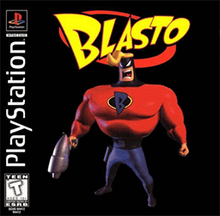Blasto (video game)
Blasto is a platforming third-person shooter game developed by Sony Interactive Studios America[1] and published by Sony Computer Entertainment for the Sony PlayStation in 1998. Although heavily marketed, the game proved too difficult for many players. Phil Hartman voiced Captain Blasto, an extremely muscular, alien-fighting, dimwitted captain.
| Blasto | |
|---|---|
 | |
| Developer(s) | Sony Interactive Studios America |
| Publisher(s) | Sony Computer Entertainment |
| Producer(s) | Jonathan Beard David Poe |
| Designer(s) | Jonathan Beard |
| Programmer(s) | Dylan Cuthbert |
| Writer(s) | Jonathan Beard Benjamin Harrison Thomas Tobey Matt Wickline |
| Composer(s) | Chuck Doud |
| Platform(s) | PlayStation |
| Release | |
| Genre(s) | Third-person shooter, Platform |
| Mode(s) | Single-player |
Gameplay
The game is a third-person action/platformer/shooter. The enemies are aliens that teleport in around the player based on events that are triggered as the player explores the environment. The game has a strong platforming factor, with elements such as rotating 3D sections which have to be navigated while shooting at aliens. Puzzle elements tend to be limited to simple "find the switch to proceed" scenarios. However, some of the elements within the game require the player to utilize different weaponry in certain situations in order to advance to the next area. Blasto is one of the few PlayStation games to use both control sticks. The left stick offers better movement control than the D-Pad and the right stick can be used to adjust the player's aim.
Plot
After returning from the 5th dimension, the diabolical alien tyrant named Bosc is bent on conquering the Planet Uranus with his own army and attempts to invade and destroy Earth as well. He is seeking to reign supreme for his power of the solar system that includes his alien army capturing and enslaving the Space Babes throughout the galaxy. Thus, Captain Blasto is the only hero who can foil him and his evil ambitions and set out to rescue the stranded Space Babes along the way. Blasto is also the only type of hero who doesn't mind catching Space Babes in distress every now and then, especially when it comes to exploring and venturing across through the Planet Uranus.
Development
Though it was not announced until the June 1997 Electronic Entertainment Expo, Blasto had been secretly in development since 1995.[2]
Wanting the game to be free of load times, the development team made the game stream constantly off the CD.[3] This made it impossible to use Redbook audio, so the music had to be done in MIDI format.[3]
None of the PlayStation's graphics libraries were used for the game, with the developers instead using custom tools and low-level programming to bring models built in Alias directly into the game.[3] Another custom tool enabled the designers to track which parts of the game world were most heavily trafficked by playtesters, so that they could tweak level design to either redirect players towards specific areas or move important elements from widely ignored areas to more heavily trafficked ones.[3]
Instead of texture mapping, vertex lighting was used to give color and definition to the floors. Because vertex lighting is a time-consuming process for artists, Sony gave the Blasto team carte blanche in taking artists from other teams to get the project completed on time.[3]
The game also had a Japanese release planned as advertised via a promo video included on Dengeki PlayStation D14 under the name Captain Blasto (キャプテンブラスト), but was cancelled for unknown reasons.
In the version of the title released in PAL regions, the original episode (level) 3 was removed due to space limitations, since the PAL version included a number of languages.
Reception
| Reception | ||||||||||||||||||||||||||||||||||
|---|---|---|---|---|---|---|---|---|---|---|---|---|---|---|---|---|---|---|---|---|---|---|---|---|---|---|---|---|---|---|---|---|---|---|
| ||||||||||||||||||||||||||||||||||
The game received "mixed" reviews according to the review aggregation website GameRankings.[4]
Next Generation reviewed the PlayStation version of the game, rating it two stars out of five, and stated that "In the end, despite all the problems, this isn't the worst game ever released for PlayStation, but it doesn't hold a candle to the best, or even the mediocre."[14]
References
- "News Bits". GamePro. No. 106. IDG. July 1997. p. 21.
- "Gaming Gossip". Electronic Gaming Monthly. No. 95. Ziff Davis. June 1997. p. 26.
- "NG Alphas: Blasto". Next Generation. No. 31. Imagine Media. July 1997. pp. 56–60.
- "Blasto for PlayStation". GameRankings. CBS Interactive. Retrieved June 12, 2018.
- Romero, Joshua. "Blasto - Review". AllGame. All Media Network. Archived from the original on November 14, 2014. Retrieved June 12, 2018.
- Fulljames, Stephen (1998). "PlayStation Review: Blasto". Computer and Video Games. Future plc. Archived from the original on July 17, 2007. Retrieved June 12, 2018.
- Edge staff (June 1998). "Blasto". Edge. No. 59. Future plc.
- EGM staff (June 1998). "Blasto". Electronic Gaming Monthly. Ziff Davis.
- McNamara, Andy; Storm, Jon; Reiner, Andrew (May 1998). "Blasto". Game Informer. No. 59. FuncoLand. Archived from the original on September 21, 1999. Retrieved June 12, 2018.
- Air Hendrix (1998). "Blasto Review for PlayStation on GamePro.com". GamePro. IDG Entertainment. Archived from the original on February 9, 2005. Retrieved June 12, 2018.
- Clint (April 1998). "Blasto Review". Game Revolution. CraveOnline. Archived from the original on June 13, 1998. Retrieved June 12, 2018.
- Fielder, Joe (April 14, 1998). "Blasto Review". GameSpot. CBS Interactive. Retrieved June 12, 2018.
- IGN staff (April 14, 1998). "Blasto". IGN. Ziff Davis. Retrieved June 12, 2018.
- "Finals". Next Generation. No. 42. Imagine Media. June 1998. p. 135.
- "Blasto". Official U.S. PlayStation Magazine. Ziff Davis. June 1998.
- Walk, Gary Eng (May 22, 1998). "Blasto". Entertainment Weekly. No. 433. Time Inc. Retrieved June 12, 2018.